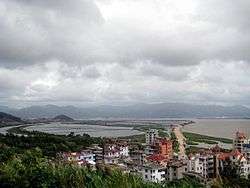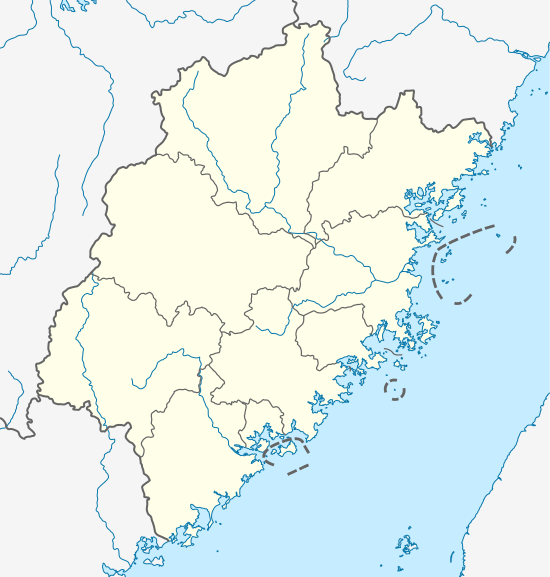Changle District
| Changle 长乐区 | |
|---|---|
| District | |
 | |
| Nickname(s): Hometown of Overseas Chinese | |
 Changle Location in Fujian | |
| Coordinates: 25°55′N 119°33′E / 25.917°N 119.550°ECoordinates: 25°55′N 119°33′E / 25.917°N 119.550°E | |
| Country | People's Republic of China |
| Province | Fujian |
| Prefecture-level city | Fuzhou |
| Time zone | UTC+8 (China Standard) |
![]()
Located 30 kilometres (19 mi) outside urban Fuzhou, Changle has a total population of 680,000 and is the hometown of more than 700,000 overseas Chinese.
Transportation
Air
The Fuzhou Changle International Airport is a major airport located in the Zhanggang Subdistrict (formerly, Zhanggang Town) of Changle. This airport services the entire northern Fujian area, and it has regular scheduled flights to many domestic and international destinations.
Major highways
Airport Express Way (Toll Road), Shenghai Express Way and Fujian Provincial Highways S201 and S203
Railways
Presently, there are no railways in Changle. (The Fuxia Railway skirts the western edge of the district, but has no stations there). The closest railway stations are in Fuzhou.
However, in November 2012 a plan has been approved for an 88.5-km-long railway from Fuzhou to Pingtan Island. The railway will run across Changle, and will have 3 stations within the district (Changle, Changle East, and Songxia (松下)). It is expected that the work will start by the end of 2012, and would take about five and a half years.[1]
Demographics
Overseas Changle
Natives of Changle receive large amount of financial support from overseas, due to there being a significant population of immigrants from Changle overseas, particularly in the US and Canada. The focal point for the US is in New York City's East Broadway of Chinatown, Manhattan. Also, Fuzhounese is commonly used in a small section of several blocks in Flushing, Queens as well as in 8th Avenue of Sunset Park, Brooklyn. A 2001 study by the Changle government found that about 400,000 people from Changle and their descendants were living abroad.[2]
The area has been nicknamed the "Hometown of Overseas Chinese" due to the large number of natives that have moved abroad.
Notable natives and residents
- One well known Changle native is author Shie Wan Yin, whose pen name is Bing Xin
- Changle is the ancestral home of Zheng Zhenduo, a master of literature.
- Naval explorer, Admiral Zheng He
Migrant workers
Currently, there are about 200,000 non-native migrant workers working in Changle. Many of them come from Sichuan province.
Tourist attractions
One of the most notable attractions in Changle is the natural environment. Situated on the banks of the Min River, the region is surrounded by many mountains and hills. There are many parks and trails which is a popular destination for locals and tourists alike. However, industrialization of the region has reduced the natural beauty of some of these areas.
Some of the tourist attractions include Xiasha Seaside Vocational Center, Jingang Leg, Bing Xing Literacy Archives, and Nanshan Park. A considerable amount of overseas remittances, particularly from the US, has been used to construct some of these areas, particularly the parks, over the last few years. Because of this, many of these areas are essentially new and attract a considerable number of visitors.
Some popular attractions are:
- Zheng He Museum and Park (郑和博物馆)
- Jin Gang Tui Park (A Buddhist's Giant Leg) (金刚腿公园)
- Bin Xin Museum (冰心博物馆)
- Qinjiang Manzu Jie (Manchurian Vallige) (琴江满族村)
- Xiasha Beach Resort (下沙海滨度假村)
- Xianyin Palace (显应宫)
- Tianfei Palace (天妃宫)
- Hexia Street (Beneath River Street) (河下街)
Culture
Local language
Most locals are capable of speaking both Mandarin Chinese (Putonghua) and the Fuzhou dialect, though Mandarin is spoken in more formal settings such as schools. Generally, everyone has a high degree of education.
At home, Fuzhou dialect is the norm. Older generations typically have a strong accent when speaking in Mandarin due to their mother tongue being the Fuzhou dialect, which does not distinguish between z and zh, c and ch, s and sh initials or n and ng finals.
The Fuzhou dialect (Changle/Fuzhou Hua-长乐/福州话) faces a high risk of lingual extinction due to the government policy that intends to push for the common use of Mandarin Chinese. Some locals are concerned that this will lead to the gradual disappearance of their cultural identity. Though the dialect is expected to remain one of the most spoken languages in the Changle area, it is primarily spoken by the older generation. Though the younger generations are fluent to a degree because of their environment and family, generational attrition of the language will cause a continual drop in the number of capable speakers. The areas where the local dialect is the strongest are primarily in the surrounding towns and areas, which are typically less economically developed than Changle.
The younger Generation prefer pop culture, arts, music and other forms of entertainment from Hong Kong and the West. The older generation of Changleners enjoy Min Opera, a form of Chinese opera.
Shopping and dining
International fast food chains have been present for along time and high end brands are trying to get in to the Fuzhounese market, with their high disposable income and expensive tastes.
Cuisine
Due to geographic location, Changle cuisine consists of a lot of seafood, such as clams, shrimps, conch, sea snails, etc.
- Fish balls (鱼丸)
- Fish Noodles(鱼面)A noodle made from fish and starch.
- Bian Rou (扁肉)Literally means "ground meat." It is Fujian style wonton soup. It features a thin wonton skin and a pork filling.
- Ban Mian (拌面)Noodles with a peanut butter like sauce. Although not native to Changle, Ban Mian is still common all over the district.
Administration
Changle is divided among four subdistricts, twelve towns, and two townships:[3]
- Wuhang Subdistrict (吴航街道)
- Hangcheng Subdistrict (航城街道)
- Zhanggang Subdistrict (漳港街道)
- Yingqian Subdistrict (营前街道)
- Meihua Town (梅花镇)
- Jinfeng Town (金峰镇)
- Tantou Town (潭头镇)
- Yutian Town (玉田镇)
- Jiangtian Town (江田镇)
- Guhuai Town (古槐镇)
- Heshang Town (鹤上镇)
- Shouzhan Town (首占镇)
- Wenwusha Town (文武砂镇)
- Hunan Town (湖南镇)
- Wenling Town (文岭镇)
- Songxia Town (松下镇)
- Luolian Township (罗联乡)
- Houyu Township (猴屿乡)
Education system
Colleges
- Fuzhou College of Foreign Studies and Trade, Changle Campus (Shouzhan Town) 福州外语外贸学院长乐校区,首占
High schools
- No.1 Junior High School (Wuhan Town) 长乐一中,吴航
- Huaqiao Junior High and Senior School (Wuhan Town) 长乐侨中,吴航
- No.2 Junior High School (Jinfeng Town) 长乐二中,金峰
- Changle Junior High School (formerly known as 'Changle Normal School', Wuhan Town) 长乐高级中学(原为长乐师范学校)
- No.3 Junior High School (Guhuai Town) 长乐三中,古槐
- No.7 Junior High School (Jiangtian Town) 长乐七中(或称长乐智化中学),江田
- No.4 Junior High School (Yutian Town) 长乐四中,玉田
- No.6 Junior High School (Yingqian Town) 长乐六中,营前
Climate
| Climate data for Changle (1981−2010) | |||||||||||||
|---|---|---|---|---|---|---|---|---|---|---|---|---|---|
| Month | Jan | Feb | Mar | Apr | May | Jun | Jul | Aug | Sep | Oct | Nov | Dec | Year |
| Record high °C (°F) | 27.5 (81.5) |
27.7 (81.9) |
31.6 (88.9) |
33.2 (91.8) |
35.1 (95.2) |
36.5 (97.7) |
38.0 (100.4) |
37.6 (99.7) |
37.8 (100) |
34.4 (93.9) |
32.0 (89.6) |
29.0 (84.2) |
38 (100.4) |
| Average high °C (°F) | 14.8 (58.6) |
14.8 (58.6) |
17.5 (63.5) |
22.3 (72.1) |
26.2 (79.2) |
29.5 (85.1) |
32.8 (91) |
32.3 (90.1) |
29.3 (84.7) |
25.5 (77.9) |
21.7 (71.1) |
17.1 (62.8) |
23.7 (74.6) |
| Daily mean °C (°F) | 11.0 (51.8) |
11.2 (52.2) |
13.5 (56.3) |
18.1 (64.6) |
22.4 (72.3) |
25.9 (78.6) |
28.7 (83.7) |
28.5 (83.3) |
25.8 (78.4) |
22.0 (71.6) |
18.0 (64.4) |
13.2 (55.8) |
19.9 (67.7) |
| Average low °C (°F) | 8.5 (47.3) |
8.7 (47.7) |
10.9 (51.6) |
15.1 (59.2) |
19.7 (67.5) |
23.3 (73.9) |
25.6 (78.1) |
25.7 (78.3) |
23.2 (73.8) |
19.2 (66.6) |
15.2 (59.4) |
10.4 (50.7) |
17.1 (62.8) |
| Record low °C (°F) | 0.1 (32.2) |
−0.2 (31.6) |
−0.4 (31.3) |
6.4 (43.5) |
10.7 (51.3) |
15.2 (59.4) |
20.1 (68.2) |
21.7 (71.1) |
16.2 (61.2) |
9.7 (49.5) |
4.8 (40.6) |
−1.1 (30) |
−1.1 (30) |
| Average precipitation mm (inches) | 47.7 (1.878) |
82.2 (3.236) |
127.2 (5.008) |
144.9 (5.705) |
167.3 (6.587) |
214.2 (8.433) |
133.2 (5.244) |
215.6 (8.488) |
188.8 (7.433) |
53.0 (2.087) |
44.4 (1.748) |
31.9 (1.256) |
1,450.4 (57.103) |
| Average relative humidity (%) | 76 | 79 | 81 | 80 | 82 | 84 | 80 | 80 | 80 | 76 | 74 | 74 | 79 |
| Source: China Meteorological Data Service Center | |||||||||||||
External links
- Changle News (Chinese)
Notes
- ↑ 福州至平潭铁路可研报告获发改委批复, 2012-11-10
- ↑ Zhao, Xiaojian (2010). The New Chinese America : Class, Economy, And Social Hierarchy. New Brunswick, N.J: Rutgers University Press.
- ↑ Changle's Government. (in Chinese)